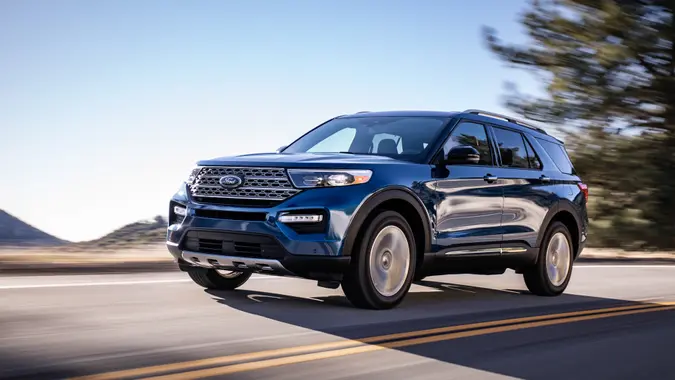Planning To Buy a Car in 2024? Don’t Forget About These 8 Expenses

Commitment to Our Readers
GOBankingRates' editorial team is committed to bringing you unbiased reviews and information. We use data-driven methodologies to evaluate financial products and services - our reviews and ratings are not influenced by advertisers. You can read more about our editorial guidelines and our products and services review methodology.

20 Years
Helping You Live Richer

Reviewed
by Experts

Trusted by
Millions of Readers
According to a GOBankingRates survey of 1,039 people in November, 38% of respondents who are contemplating a major financial milestone in 2024 are planning to buy cars.
Buying a car is simple enough. Find one you like for a price that’s agreeable, sign some paperwork and take your new ride home. But the sticker price you see on the window isn’t where your financial obligations will end.
Here are eight expenses to consider when purchasing a car.
Down Payment
According to Kelley Blue Book, the standard down payment when purchasing a car is 20%. That means if you buy a $40,000 vehicle, you would put down $8,000. Although you don’t necessarily have to make a 20% down payment, it can help you pay less in the long run.
First, a down payment can reduce the amount of the loan you need to buy the car, which means you can pay off the loan faster. Paying off the loan faster means that you’ll pay less in interest. Additionally, owing less on the car from the beginning can help keep you from getting “upside-down” in your loan or owing more on the vehicle than it’s worth as it depreciates.
The Interest You’ll Pay Over the Life of the Loan
This is a big one. AAA’s “Your Driving Costs” report for 2023 found that people who purchased 2023 vehicles effectively signed up for an average annual finance cost of $1,253 per year.
Over five years, that’s a staggering $6,265. And that’s a cost on top of the sticker price.
Dealerships often offer attractive incentives, such as cash back, if you choose to finance through them. Before discussing financing with the dealership, however, visit your bank and get preapproved for car financing. Then, use it as a negotiating tool in case the dealership offers a higher financing rate.
Extended Warranty
The finance manager at the car dealership likely will try to sell you an extended warranty on top of what the manufacturer offers. According to Motor1.com, extended car warranties range in price from $2,000 to $5,000, with the average cost around $3,000. Factors such as your location and the specific vehicle will determine the actual cost.
GAP Insurance
The finance manager also might offer you general asset protection insurance — aka GAP insurance. GAP insurance covers the difference between what your car is worth and the balance you owe on the loan if it sustains damage beyond repair in an accident or is stolen. Dealerships typically sell this coverage for a flat fee of $500 to $700. However, you also might be able to obtain GAP insurance through your car insurance provider.
Car Insurance
You must have at least the minimum liability insurance coverage as required by your state. But you might want additional coverage. AAA’s YDC report found that the average driver under 65 who lives in the city or suburbs and has at least six years of driving experience with no accidents will pay $1,765 annually for full coverage. You could end up paying much more or less, depending on your age, location, vehicle type, driving history and other factors.
Fuel
According to AAA’s YDC report, you’ll pay an average of 15.9 cents per mile at a fuel price of $3.99 per gallon. Of course, that cost will change depending on the type of vehicle you drive (and the price you pay at the gas pump). For example, the average cost for a small sedan is 11.8 cents per mile, but a medium-size SUV costs 16.6 cents per mile.
Maintenance, Repair and Tires
The average cost of maintenance, repair and tires, according to AAA’s report. is 9.8 cents per mile. That includes the parts and labor required for routine maintenance, a comprehensive extended warranty, one set of replacement tires and repairs to wear-and-tear items over five years of operation.
Depreciation
This is another big expense. AAA’s report calculates that, on average, vehicle owners will experience a whopping $4,538 loss in value per year — or over $22,000 in five years. This calculation is based on the difference between a new car’s purchase price and estimated trade-in value at the end of five years and 75,000 miles.
 Written by
Written by  Edited by
Edited by 

























